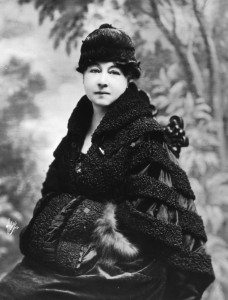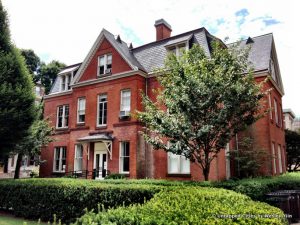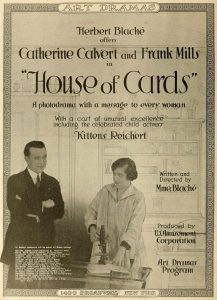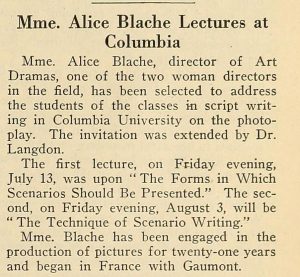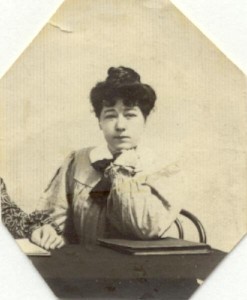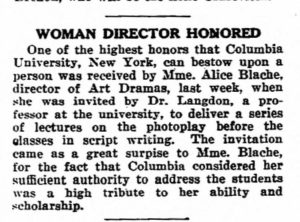Alice Guy Blaché at Columbia University: One Hundred Years Later
Earlier this spring, while rereading a portion of Alison McMahan’s book Alice Guy Blaché: Lost Visionary of the Cinema, I was reminded that, in the summer of 1917, Columbia University invited the eponymous film director, producer, screenwriter, and studio head to come give two lectures on the art of cinema. These lectures took place on the evenings of July 13 and August 3, 1917, two Fridays during the university’s notable Summer Session. Having been involved with the Women Film Pioneers Project for a while, I have always been aware that Guy Blaché visited Columbia at some point, but I knew nothing else and, admittedly, hardly thought about it. However, realizing that the centennial was approaching, I wanted to learn more. With no idea if there was anything more to even find (or what I was looking for), I began to dig. As you would expect, my small-scale archival scavenger hunt was ultimately one with infuriating absences, endless questions, and fascinating contradictions. It also was an exciting opportunity to reflect on WFPP’s mission and its place within the broader history of film studies at Columbia.
In conceptually reconstructing this moment in the summer of 1917, I depended upon a mix of sources, from trade press and newspaper articles to secondary scholarship on the history of film education at Columbia. A mere two pages in Guy Blaché’s memoirs provided further insight into this time in the filmmaker’s career. Online resources such as the archives for The Columbia Spectator and the Media History Digital Library allowed me to access an incredible number of digitized articles from the period. The Columbia University Archives, housed in the Rare Book and Manuscript Library here, contained a variety of materials—from faculty appointment cards and event announcements to Summer Session bulletins and lecture tickets—that offered a glimpse of Columbia activities at that time. After conducting some of this research, I was baffled with how to proceed. It is easier to celebrate the centennial of a film—you screen it, if it exists and is available. But what about events—ephemeral in nature—of which there is little information to be found and nothing really to watch? Certainly, a focus on the extant output from these early women filmmakers is necessary and a vital part of scholarly initiatives like WFPP, but simply screening one of Guy Blaché’s films at Columbia this summer did not feel like the most appropriate form of celebration. Instead, I decided to present my findings in a loose narrative and recreate the events of the summer of 1917 in writing. I chose to model this informal chronology—very much a work in progress— after the WFPP profiles, which allow space for a mix of concrete historical findings, speculation, and commentary.
What do we know about these two lectures? We know that Guy Blaché was most likely invited by professors at Columbia sometime in the spring of 1917. Having recently sold 51% of Solax to ward off debt, the director was then working under the banner of the U.S. Amusement Corporation (McMahan 2002, 186, 189). At forty-four years of age, Guy Blaché was still collaborating with her husband, Herbert Blaché, on upcoming cinematic projects. In The Memoirs of Alice Guy Blaché, the director recollects that when “the professors at Columbia University paid me the great honor of an invitation to give a talk about cinema to their students,” she and Herbert were developing the scenario for House of Cards (1917), which was released in June 1917 and is now considered lost (Guy Blaché 1986, 68; McMahan 189). Guy Blaché explains that she was hesitant to agree to Columbia’s request, as her “English was faulty” and suggested her husband go in her place (69). However, the unnamed professors were adamant she come. “…[I]t’s you we want!” they apparently said, “…Because you’re a woman” (69). This emphasis on Guy Blaché’s gender is also evident in the two press mentions that I found regarding these summer lectures. In July 1917, The New York Clipper announced the lectures with the headline “Woman Director Honored” (36), while, in August 1917, Motion Picture News called her “Mme. Alice Blache” and identified her (incorrectly) as “one of the two woman [sic] directors in the field” (981). It seems very likely that Columbia was interested in having Guy Blaché lecture because of her already lengthy transnational filmmaking career and because she was a woman. Guy Blaché was apparently aware of this fixation on her gender, stating in her memoirs that this “anecdote [Columbia’s request and the subsequent lectures]…illustrates very well the interest taken by the American public in a woman’s career” (68).
According to the director’s memoirs, the first lecture on July 13 was in a classroom. She describes her arrival and the discovery of “groups of men and women students in the classroom, some seated on the ground” (69). It could be that this first lecture was held in Room 201 in East Hall on campus. As far as I can tell, this is the previous name for the current Buell Hall (home today of Columbia’s Maison Française), but the physical location and size of the building may have changed between then and now. The 1917 Summer Session bulletin lists this room as the location for the Photoplay Composition classes, which were taught by Dr. Victor O. Freeburg1I have doubts about Freeburg’s involvement in Photoplay Composition during the 1917 Summer Session. His faculty appointment card in the Columbia archives shows him resigning from the Summer Session on July 1, 1917, only 8 days before the program started (but after the bulletins were printed and circulated). This is substantiated by Richard Koszarski, who says that Freeburg taught at Columbia until the spring of 1917 (95). I have a hunch that he resigned before the session started—we know he was in the naval reserves by the fall of 1917, as reported by The Columbia Spectator on September 26, 1917 (1)—and perhaps Patterson quickly took over. Finding Patterson’s appointment card, if it exists in the archives, is the next step. and held at 9:30am (Elementary) and 10:30am (Intermediate) (90). While Guy Blaché’s lecture was held in the evening, The New York Clipper states that she was invited for the express purpose of “[delivering] a series of lectures on the photoplay before classes in script writing” (36), so it seems likely that the first talk took place in that classroom. Additionally, since this event was on a Friday evening and publicized in at least two news outlets, there’s a chance that it was also open to the public, perhaps through the Institute of Arts and Sciences (a division of the University Extension program established in 1913 that focused on cultural or artistic educational events, such as evening concerts, lectures, and recitals).2To date, I have found that the Institute did a broad range of public evening lectures during the academic calendar, but there is no record of any events during the summer months (or at least no materials concerning summer events saved in the specific files that I looked through). However, I have found no concrete evidence to support this claim so far.
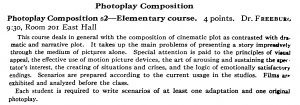
Photo of 1917 Summer Session bulletin, University Extension Files, University Archives, Rare Book & Manuscript Library, CU.
It is necessary to pause here and give some background on Photoplay Composition at Columbia. The course was first offered in the fall of 1915 through University Extension, an adult-education program within the university that evolved in different guises from as early as 1830 (Burrell 1954, 3-4). By the time the 18th edition of the Summer Session—part of the University Extension program—rolled around in 1917, Photoplay Composition had been in existence for approximately two years and, according to an April 1917 New York Times article, sixty students were registered for the course during that spring (X5). It was first taught by Freeburg and then by Frances Taylor Patterson.3Decherney provides a detailed look at the fascinating context and origins of Columbia’s early film course, especially in regards to the involvement of industry figures in its creation. Both instructors were interested in the techniques of photoplay construction and development (plot structures, visuals, character psychology). They saw the potential for this new medium to be a “force of artistic uplift” and the necessity of training students—through weekly screenings, script writing exercises, and visiting industry lecturers—to be skilled makers and cinemagoers (Polan 2007, 8). Within the context of University Extension, these early Photoplay Composition classes were part of Columbia’s larger pedagogical mission to provide non-credit educational opportunities and professional training for individuals—workers, immigrants, housewives—who were not able to attend school in a traditional manner or perhaps would never have been admitted to Columbia otherwise (Burrell 9-10; Decherney 2000, 449, 451). While adult education/extension teaching was not exclusive to Columbia at that time, scholars have documented the relationship between the program at Columbia and the institution’s early film courses (arguably the first of their kind). For both Peter Decherney and Dana Polan, University Extension at Columbia was a space of learning that was perhaps not as highly controlled or respected as the regular degree-granting programs. As Decherney argues, “As Columbia redefined its mission to accommodate its changing constituency, the University frequently used its adult education school as ‘an experiment station’ for new programmes’” that would most likely not be given the same freedom to develop in the University-proper (452). For Polan, “offered in the nether region of extension programs…removed from the mainstream humanistic mission of institutions of higher learning, the first film courses slipped stealthily into the academic context…” (35).4Polan uses a 1916 budget breakdown for the extension division to illustrate “the place of Photoplay Composition in the overall scheme of things” (40). In 1916, the “total budget for the extension division was $130,516 with $10,850 allotted to English, a very successful track in terms of enrollment, while a mere $350 was designated for what was termed the film ‘department.’”
In front of these diverse Photoplay Composition students, what did Guy Blaché speak about on July 13, 1917? McMahan describes the topic of this first lecture as “What themes to pick and how to handle dramatic situations, the rules of censorship in the different states and copyright laws” (189). On August 11, Motion Picture News reported that the first lecture was on “The Forms in Which Scenarios Should be Presented” (981). In Guy Blaché’s own words, the first lecture comes across as a bit more personal, almost like a revisiting of her career both in France and later in America with Solax: “I told [them], as best I could, of the difficult beginnings, our joy at each discovery, the hope we founded on the next generation, and what they might draw from our discoveries. I invited them to visit the studio” (69). With these inconsistencies in mind, it is apparent that the first lecture was somewhat focused on screenwriting, but seems to have been a more general celebratory career retrospective or masterclass—to borrow a contemporary term—with a respected filmmaker.
The lecture on August 3, 1917 was apparently held in a much larger space than before. Guy Blaché remembers that she was told that the “second lecture would take place in the big conference hall which held 3000 persons” (69). What lecture hall was this? Was it an auditorium at Horace Mann School in Teacher’s College, which was regularly used for Institute of Arts and Sciences events at that time (Burrell 27)? Or was it in a screening space in the School of Journalism, which was used as early as 1914 for outside classes—for example, in economics, literature, and psychology—to watch motion pictures related to their coursework (Voorhies 1915, 93; Decherney 451)? These questions remain unanswered for now, but are conceivable starting points for future research. Unfortunately, wherever the event ultimately took place, it seems like it was not well-attended, which pleased the nervous Guy Blaché: “Happily for me, on that occasion the weather was dreadful and the audience was small” (69).
As for the topic, Motion Picture News announced that this second lecture would be on “The Technique of Scenario Writing” (981), which corresponds to what McMahan identifies as “How to write the screenplay” (189). Evidently, the subject matter was more technical this time and focused on relaying the skills necessary to be an effective screenwriter. Since this second lecture was in a large auditorium, Guy Blaché recalls that she was asked to bring a film to accompany her talk. She apparently chose the aforementioned House of Cards (produced by U.S. Amusement Corporation and distributed by Art Dramas), which was a five-reel family drama starring Catherine Calvert, Frank Mills, and Kittens Reichert. Trade press articles tell us that the film focused on a family in which both parents worked—she as a doctor and he as the District Attorney. Neglected, their young daughter runs away with the help of a servant boy and her parents’ marriage consequently unravels. Eventually, the father, while investigating factory conditions and child labor, finds his daughter alive and working in one such factory. Allegedly, House of Cards was more concerned with the wife’s responsibility as a mother. In his review for Motion Picture News, Peter Milne writes “this picture advances the preachment that woman’s place is in the home before in the office, even though in the latter place she may labor long and hard for the benefit of humanity” (4108). Guy Blaché uses her memoirs to explain how she and Herbert developed this scenario—a description worth relating here since it is probable that it was part of her talk on scenario development on August 3. According to Guy Blaché, she and Herbert wanted to create a story about a couple who shared a career. Herbert thought that the theme as they had it was treated too seriously, apparently arguing “We’re not merely addressing ourselves to an audience of intellectuals, but one of peasants, also, of miners and cowboys. One must lighten this with a few gay scenes’” (68). Consequently, Guy Blaché says that she decided—due to the public’s interest in child labor at that time—to include the part about the young girl running away from her parents and finding employment in a factory. While the couple in House of Cards does not share the same profession, it is evident that the film was concerned with issues relating to the idea of a woman’s career outside of the home, an interesting point given the fact that Guy Blaché was invited to speak at Columbia as a female professional. It is not difficult to imagine that Guy Blaché related how she and Herbert came up with the plot for House of Cards to her audience at Columbia, thus presumably presenting the aspiring screenwriters with a model for how to develop a story, mix differing themes, and be mindful of the audiences’ expectations.
Even if the second lecture was not well attended (and we have no sense of the size of the audience in July), Guy Blaché’s two lectures can be understood as successful. Topically, they were very much aligned with the larger mission of the Photoplay Composition course: to better understand the cinematic industry and form, specifically the scenario, at a time when the medium was rapidly becoming understood as a legitimate art form, as well as a central part of popular culture, the global economy, and everyday life. Guy Blaché’s lectures can be understood as one small part of the course’s mission at the time to professionalize the craft of screenwriting for a broad range of students. It appears that on both occasions students and faculty were in the audience, and everyone seemed to respond vocally to the material that she presented. Guy Blaché describes the conclusion of her second lecture, as she was “surrounded and complimented very politely” (69). Some professors apparently were critical of the inclusion of the storyline dealing with the children, but the director laughs this off in her memoirs, saying that it is quite challenging (for a woman) to “[please] ‘all the world and one’s father’” (68).
Given the scarcity of information on Guy Blaché’s visits to Columbia, many questions remain. Who specifically invited her to speak? Guy Blaché utilizes the plural “professors” when talking about her invitation. Was Freeburg and/or Patterson part of this group? The two short articles that I found regarding these lectures both name a “Dr. Langdon” as the individual who extended the invitation. However, I have been unable to find any record of a Dr. Langdon anywhere in the Columbia archives. According to The New York Clipper, he was a professor at the university, but I have yet to find a faculty appointment card for him. His name is not in any of the general faculty files that I have looked through or in any of the University Extension materials. What was his department or program affiliation? Did he have anything to do with Photoplay Composition? For now, this Dr. Langdon remains a maddening mystery.
The question of who invited Guy Blaché to Columbia becomes more complicated when looking at other sources. McMahan tells us that Guy Blaché was invited by the School of Journalism (190). The connection between early film classes and the School of Journalism is supported by Vachel Lindsay, who, in his book The Art of the Moving Picture, states that an earlier edition of the text was used by “Victor O. Freeburg as one of the text-books in the Columbia University School of Journalism, in his classes in photoplay writing” (2). However, I believe that connecting the nascent film classes with the School of Journalism is incorrect. It is well-documented that the Photoplay Composition classes were part of the University Extension program and do not seem to have any administrative connection to the School of Journalism, which opened in 1912. I believe the fact that the School of Journalism had a screening room for outside classes to utilize as early as 1914 may have falsely connected it to the study of motion pictures at Columbia. According to documents in the Columbia archives, later Photoplay Composition classes (for example in 1923), taught by Patterson, were held in classrooms in the School of Journalism, but it seems as if they were still separate from the latter. Another factor in this confusion might be the fact that Freeburg did lecture before journalism students in October 1916, but these, as reported by The Columbia Spectator, seem unconnected to his regular teaching. On October 10, the campus newspaper reported that Freeburg was present to give an educational talk on “The Social Function of the Motion Picture,” which was part of what seems to be a regular Tuesday afternoon lecture series at the School of Journalism (3). According to the school newspaper the following day, Freeburg outlined cinema’s democratic and educational values and argued that “It is the duty of you journalists…to create a public demand for better motion picture plays by showing the people how to pick the good from the bad” (7). It seems like this was a one-time event, although the earlier article in The Columbia Spectator reports that students would be required to hand in weekly reports, making it sound like this could become an ongoing meeting or class (3). However, I have not seen any other mention of Freeburg speaking to journalism students. I would like to find a way to access any archival collections related to the School of Journalism’s history, which perhaps could prove useful in clarifying the relationship between the program and early film classes at Columbia.
While we may never know who invited Guy Blaché to Columbia, her memoirs outline that she “kept up friendly relations” with some of her contacts there (88). Following the summer of 1917, Guy Blaché remained in the United States for only a few more years, eventually moving back to France in 1922 after her divorce from Herbert and the liquidation of her studio in New Jersey (McMahan 204). Guy Blaché writes that she “remained on good terms with the Columbia professors, and the pentagonal figure (of the university?) gave me the idea of a little cinematography college which might take that form, each branch being reserved for a particular science” (69). It is unclear how much time passed between her lectures and this suggestion of a “cinematography college.” It seems likely that she is referring to efforts at Columbia in the mid-1920s to form a legitimate degree granting program in film. According to Polan, “At the end of 1926, [Nicholas] Butler put together a committee to investigate the possibility and desirability of creating a ‘School of Moving Picture Technology,’ and a far from insignificant effort was expended in negotiating such a school with film industry luminaries” (80). In early 1927, letters were even sent out from Columbia and the office of Will Hays (who was collaborating on this initiative) to industry figures for feedback (Polan 81). Additionally, Polan’s research highlights that the planning group anticipated three tracks for this program: cinema architecture, cinema photography, and cinema writing (83), which together covered both the business and technical aspects of film production and may correspond to the “branches” that Guy Blaché mentions. Is Butler the “pentagonal figure” to whom Guy Blaché alludes? Was she one of the “film industry luminaries” contacted even though she had moved back to France? McMahan briefly indicates that Guy Blaché came back to the United States in 1927 to locate copies of her films (xxii), but it is unclear exactly when this trip occurred. In her memoirs, Guy Blaché does say “…if my stay in the United States had been longer we would certainly have tried to do something of the sort, Columbia University being disposed, it seems, to finance the costs” (69). Whenever I previously read this passage, I just assumed she meant her time in America prior to moving back to France, but now I wonder if she was referring to her brief trip back. This passage also highlights the difficult task of using memoirs as sources—in Guy Blaché’s words, this “cinematography college” sounds as if it was suggested by Columbia to only her and that she was vital to its creation. However, as Polan has outlined in detail, there were many factors at play (and people involved) in Columbia’s actual efforts to start this film school, which ultimately never came to fruition at that time.
***
It strikes me now that I undertook this reassembling of Guy Blaché’s visit to Columbia—and the context surrounding these events—for personal reasons. I enjoyed the challenge of trying to reconstruct something ultimately unknowable, just as much as I liked the idea of finding some elusive clue (Saying what? I don’t know). It is exciting to think that Guy Blaché was at my alma mater and place of work, just as it is exciting to imagine who was in the audience and the content of her lectures. (Did they ever take her up on her offer to visit the studio?) More importantly, it was a way of reminding myself that these “women film pioneers” that I interact with daily were real people. I was fascinated by how nervous Guy Blaché says she was about giving these lectures in English and her description of the first lecture: “A little platform had been prepared for me. I climbed up and took some few seconds to find my voice. Finally, I gathered my courage and chose a sympathetic face to address” (69). I also love that she was happy that the inclement weather decreased the size of the audience at the second lecture. Not only does this give us a sense of the day/event, but it also allows a figure, who has, unfortunately, become almost just a data point for me—evidence of women’s involvement in early cinema—to be humanized.
The summer of 1917 also marks a fascinating point of intersection between Guy Blaché and Columbia’s early film courses. One was on the rise, while the other was, in many ways, on the decline. The summer of 1917 was still just the beginning of Columbia’s academic relationship to cinema—a legacy that has included collaborations with Iris Barry and the Museum of Modern Art, the development of a degree-granting program within the School of the Arts, professors like Andrew Sarris, and the launch of the Women Film Pioneers Project in 2013. However, in 1917, Guy Blaché had by then enjoyed an already long transnational filmmaking career as one of the earliest film directors and producers. She had owned and operated her own studio and made hundreds of films across numerous genres. As Motion Picture News pointed out at the end of its blurb on her Columbia lectures, “Mme. Blache has been engaged in the production of pictures for twenty-one years…” (981). Similarly, The New York Clipper reported that “The invitation came as a great surprise to Mme. Blache, for the fact that Columbia considered her sufficient authority to address the students was a high tribute to her ability and scholarship” (36). In both cases, the heft of her lengthy career is foregrounded in a way that today strikes me as being cognizant of the fact that the bulk of her work was already behind her.
One hundred years later, I started this research project secretly hoping to find some evidence of these lectures—a program, a ticket, anything that mentioned Guy Blaché’s name and was proof that she was here—in campus archives. While I may not have found any such materials, I did get a better sense of Columbia’s attention to film education in 1917 and Guy Blaché’s small role, as a notable female filmmaker, in that larger mission to institutionalize cinema as a viable educational track—a field of study that ultimately marginalized her. The irony that WFPP—which is fueled by this broader absence of women like Guy Blaché from standard film histories and canons—is now located at Columbia is not lost on me. Ultimately, in describing what little I know—and what I do not—of these events, I am reminded that a woman’s participation in early cinema can take many shapes, from an extant film that she directed and wrote to fleeting and intangible evening talks on the nature of an emerging art form.
See also: “Research Update: Alice Guy Blaché at Columbia University”
Bibliography
Burrell, John Angus. A History of Adult Education at Columbia University. New York: Columbia University Press, 1954.
“Columbia Resources Now Contributing to Every Department of Service.” The Columbia Spectator (26 September 1917): 1-2.
Decherney, Peter. “Inventing Film Study and Its Object at Columbia University, 1915-1938.” Film History vol. 12, no. 4 (2000): 443-460.
“Domestic Problem—Modern Ideas Questioned in ‘House of Cards.’” Motion Picture News (16 June 1917): 3754-5.
“Dr. Freeburg at Journalism, To-day.” The Columbia Spectator (10 October 1916): 3.
Guy Blaché, Alice. The Memoirs of Alice Guy Blaché. Ed. Anthony Slide. Trans. Roberta and Simone Blaché. Metuchen, N.J.: The Scarecrow Press, 1986.
“Home-Made Motion Pictures Predicted for Near Future.” New York Times (22 April 1917): X5.
Koszarski, Richard. An Evening’s Entertainment: The Age of the Silent Feature Picture, 1915-1928. Berkeley: University of California Press, 1990.
Lindsay, Vachel. The Art of the Moving Picture. New York: Macmillan, 1922.
McMahan, Alison. Alice Guy Blaché: Lost Visionary of the Cinema. New York: Continuum, 2002.
Milne, Peter. “House of Cards.” Motion Picture News (30 June 1917): 4108.
“Mme. Alice Blache Lectures at Columbia.” Motion Picture News (11 August 1917): 981.
Polan, Dana. Scenes of Instruction: The Beginnings of the U.S. Study of Film. Berkeley: University of California Press, 2007.
“Talk on Movies by Dr. Freeburg.” The Columbia Spectator (11 October 1916): 7.
Voorhies, J. “Columbia Movies.” Motion Picture Magazine (August 1915): 93-94.
“Woman Director Honored.” The New York Clipper (25 July 1917): 36.
Archival Paper Collections:
University Extension Files, Summer Sessions Files (1917 Summer Session Bulletin), Division of Film Studies, 1920s-1930s Files, and Faculty Appointment Cards. Columbia University Archives, Rare Book and Manuscript Library, Butler Library, Columbia University.
Notes
Citation
Saccone, Kate. "Alice Guy Blaché at Columbia University: One Hundred Years Later." In Jane Gaines, Radha Vatsal, and Monica Dall’Asta, eds. Women Film Pioneers Project. New York, NY: Columbia University Libraries, 2017. <https://doi.org/10.7916/d8-aycv-qd47>

